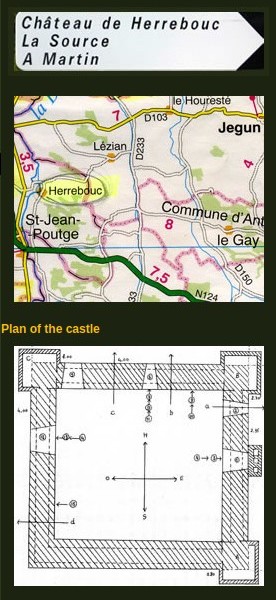
 Chateau Herrebouc is situated in the commune of Saint-Jean-Poutge.
Chateau Herrebouc is situated in the commune of Saint-Jean-Poutge.
The castle does not sit atop a hill but, rather, in the valley and on the river’s edge. “In contrast to the majority of the other castles, one doesn’t climb a hill to reach it but, rather, one descends towards the [river] Baïse that laps at one’s feet.” René Caïrou.
The castle was certainly a stronghold or tower of the fourteenth century. Its existence is mentioned in a text from 1344, stating that Pelegrine de Ferrabouc, widow of Géraud de Mimo and heiress of Guillaume de Commère, swore “loyalty and homage” to Jean, count of Armagnac and Rodez, in exchange for “his chateau of upper Ferrabouc”, situated in Fezensac.
This castle is located about 30 meters from a water mill and, as Philippe Lauzun says, “For a time, the chateau of Herrebouc was thought to be the mill itself; and it is not rare to hear today, speaking of the [chateau], the Herrebouc mill. Its resemblance to the fortified mills of Gironde of the thirteenth and fourteenth centuries could fool somebody, even for just a moment.”
The dwelling, 16 meters high, includes a ground floor and three upper floors of the same height.
At its base, the structure measures 13.3 meters by 12.2 meters, and the walls are 1.6 meters thick.
The style of construction confirms its age, from the end of the thirteenth or beginning of the fourteenth century:
“Its walls, admirably covered with a bond much used from 1250 to 1350, their regular thickness, 1.6 m., which is like all the chateaux of that era, the form of its watchtowers and especially that of their machicolated walls leaves no doubt.” P. Lauzun.
In the sixteenth century, openings were pierced on all the façades, with an eye to making the dwelling more comfortable. In fact, it is likely that, like other towers of that time, the ground floor was originally entirely sealed, the only entrance being by way of a ladder suspended from the tower’s first floor.
According to René Caïrou, the interior décor and sculptures are not as elegant as that of the towers of Tauzia and Larressingle, although he concedes that the structure does possess a sober beauty.
Philippe Lauzun has given us a description of the beautiful fireplaces on each floor and one of them in particular, above whose mantel one can still make out a fresco representing a mysterious and elegant young lady wearing a red scarf and sporting a high, wide bodice, leading us to believe that the image dates from the Valois epoch (the French kings who reigned between 1328 and 1589). Other remains of murals are also visible depicting floral patterns, foliage, coils and fruits.
This fortified dwelling apparently played a defensive role, but in a very different way compared to the hilltop castles. For Philippe Lauzun, “its only role was to defend the real mill nearby, while serving as a fortified habitation for the old and powerful family that gave it its name. But its defensive value is no less interesting for that, considering the thickness of the walls and the [structure’s] height which effectively protected it from every type of battering ram or weapon of that time. The watchtowers that give it so much charm today are authentic shooting galleries disposing of a machicolated defense with eight openings.”
The seigneurs of Herrebouc
Four great families succeeded each other at Chateau Herrebouc from the High Middle Ages to the French Revolution.
- First, the Ferrabouc family (or Ferraboc, Ferrebouc or Herrebouc as the name was variously written in the Middle Ages), an important family from the town of Fezensac, occupied the castle up to the fifteenth century. The name Ferrabouc appears as early as the beginning of the thirteenth century, well before the construction of the castle.
“The Ferrabouc always had the patronage of their suzerains, the counts of Armagnac, and throughout the fourteenth century we find them constantly by their side (…) We could endlessly enumerate all the exploits of the Ferrabouc family, ever more powerful, and whose name can be found in every page of the history of Gascony at the end of the fourteenth century and throughout the fifteenth century.” Philippe Lauzun.
- The Castelbajac family succeeded them during the fifteenth and sixteenth centuries, a very old family divided into numerous branches and whose barony is situated in Bigorre. “In addition to the main branch, which goes from the year 1000 to the middle of the sixteenth century, we should cite the branches of Rouèdes, Bernet, Lisos, Saint-Paul, Calrac, Lubert, Casteljaloux and, finally, Cabanne and Barbazan.”
Philippe Lauzun.
This illustrious family still exists today, their standard carried on by the descendants of the Marquis of Castelbajac, a squire to Emperor Napoleon III. They are the current owners of Chateau Caumont.
- After the Castelbajacs, the Verduzan family moved in and stayed until 1870. This valiant Gascon family, which goes back to the twelfth century, counts among its ancestors Hughes de Verduzan, one of the Gascon Captains who fought alongside La Hire and Ponton de Xaintrailles during the time of Jeanne d’Arc.
Today, Chateau Herrebouc is a winery.
